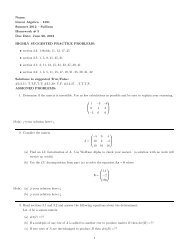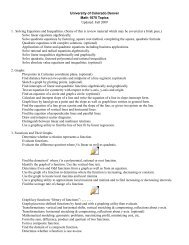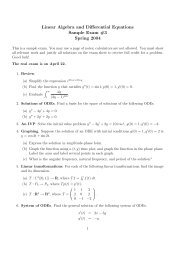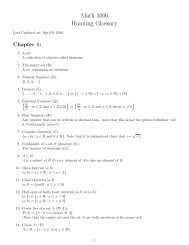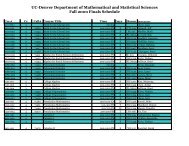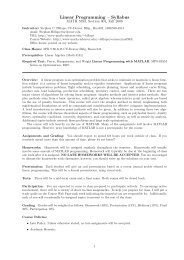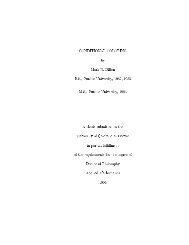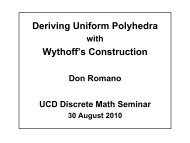A Game-Theoretic Approach to Personnel Decisions in American ...
A Game-Theoretic Approach to Personnel Decisions in American ...
A Game-Theoretic Approach to Personnel Decisions in American ...
Create successful ePaper yourself
Turn your PDF publications into a flip-book with our unique Google optimized e-Paper software.
As a notational convenience, let<br />
D(δ,x) = (ar,p − ar,r)(1 + δx) + (ap,r − ap,p)(1 + x).<br />
To f<strong>in</strong>d the defensive Nash equilibrium functions, we perform a similar calculation<br />
<strong>to</strong> that used <strong>to</strong> obta<strong>in</strong> (2). The defensive Nash equilibrium functions<br />
are<br />
Rdef(δ,x) = (ar,p<br />
and<br />
− ap,p) + x(δar,p − ap,p)<br />
D<br />
(3)<br />
Pdef(δ,x) = 1 − Rdef(δ,x) (4)<br />
where Rdef(δ,x) and Pdef(δ,x) denote the Nash equilibrium proportions for<br />
run defense and pass defense, respectively.<br />
These equilibria provide optimal mixed strategy solutions <strong>to</strong> the game<br />
<strong>in</strong> terms of x and δ. We limit x <strong>to</strong> the closed <strong>in</strong>terval [0, 1], because large values<br />
of x result <strong>in</strong> unreasonable <strong>in</strong>creases <strong>in</strong> the expected yards per play, even for<br />
reasonable choices of ar,r, ar,p, ap,r, and ap,p. We feel that the assumption<br />
that a new quarterback will at most double the pass<strong>in</strong>g efficiency of a team is<br />
reasonable, and aga<strong>in</strong> the model is readily adaptable.<br />
Next, note that s<strong>in</strong>ce (1+x) > (1+δx), there may exist some x0 ∈ (0, 1]<br />
such that the pass<strong>in</strong>g row <strong>in</strong> Table 2 will be dom<strong>in</strong>ant for all x ≥ x0. We refer<br />
<strong>to</strong> this value as the break<strong>in</strong>g po<strong>in</strong>t of the model, s<strong>in</strong>ce it is the po<strong>in</strong>t where the<br />
offense would logically transition <strong>to</strong> a pure strategy. We note that break<strong>in</strong>g<br />
po<strong>in</strong>ts do not always exist <strong>in</strong> (0, 1], and <strong>in</strong> these cases, the game is a mixed<br />
strategy game for all x ∈ (0, 1]. In fact, we put forth that the presence of<br />
a break<strong>in</strong>g po<strong>in</strong>t <strong>in</strong> our model provides a reasonable bound on the value of<br />
x, as it does not seem realistic that new player personnel would lead a team<br />
<strong>to</strong> completely abandon the runn<strong>in</strong>g game, even if this may be called for <strong>in</strong> a<br />
narrow set of game situations.<br />
However, <strong>in</strong> the case that a break<strong>in</strong>g po<strong>in</strong>t does exist <strong>in</strong> (0, 1], the<br />
follow<strong>in</strong>g development is necessary for completeness. Recall that we assume<br />
ar,r < ap,r and ar,p > ap,p. Under these assumptions, the break<strong>in</strong>g po<strong>in</strong>t<br />
is easily computed as the value of x satisfy<strong>in</strong>g the equation ap,p(1 + x) =<br />
ar,p(1 + δx). The follow<strong>in</strong>g proposition reflects this.<br />
Proposition 1 If ar,r < ap,r and ar,p > ap,p, then the break<strong>in</strong>g po<strong>in</strong>t of the<br />
game given <strong>in</strong> Table 2 is<br />
(ar,p − ap,p)<br />
(ap,p − δar,p) .







